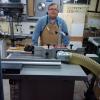I wonder if Hammer A3 users of this forum could give me some advises.
I bought A331 a year ago and it has been a smooth operator. However, the feed roller becomes a bit cranky these days. Often times, it is reluctant to receive a stock. It's not a big deal for surface plaining, but when the stock is standing on its edge, it sometimes dent the leading edge of the stock that meets the roller.
I suppose the spring of the roller gets too tight or the moving mechanism is gunked up but when it comes to the feed roller adjustment, the manual says, "contact service".
Have you experienced this symptom and if so could you adjust the machine?
thanks in advance.




 Reply With Quote
Reply With Quote ) - but it specifies tolerances for the various alignments, and how to test them. You may find you want to adjust to rather tighter tolerances than are specified. (can't imagine why this might be either)
) - but it specifies tolerances for the various alignments, and how to test them. You may find you want to adjust to rather tighter tolerances than are specified. (can't imagine why this might be either) 


